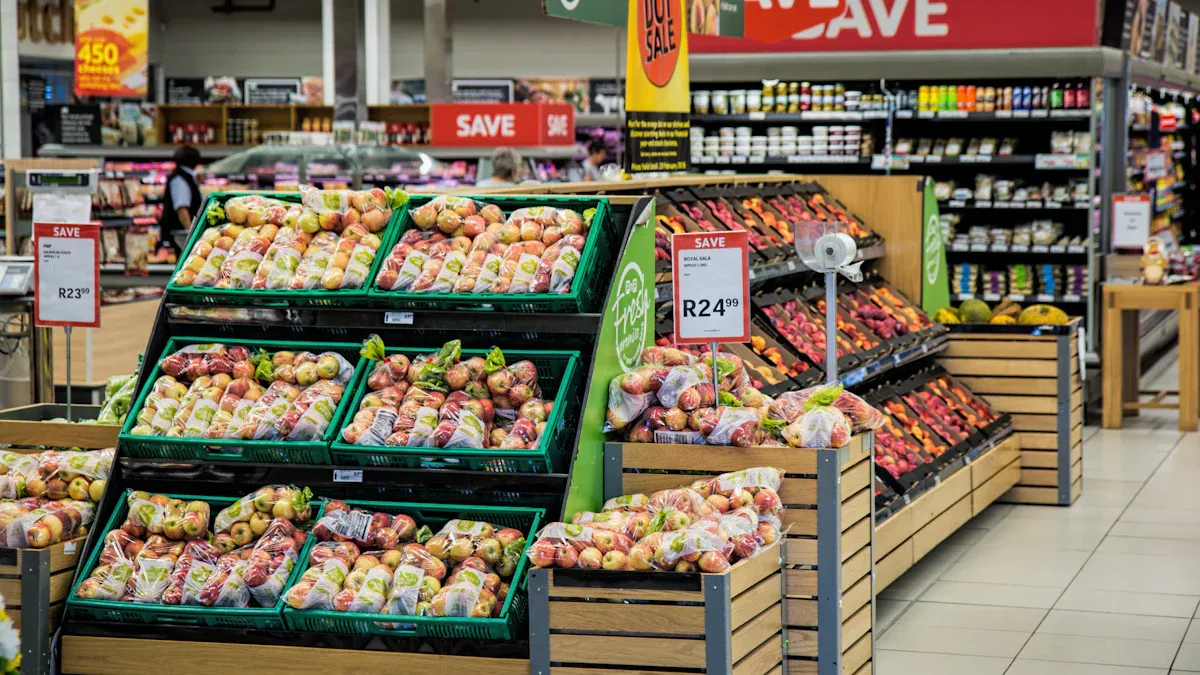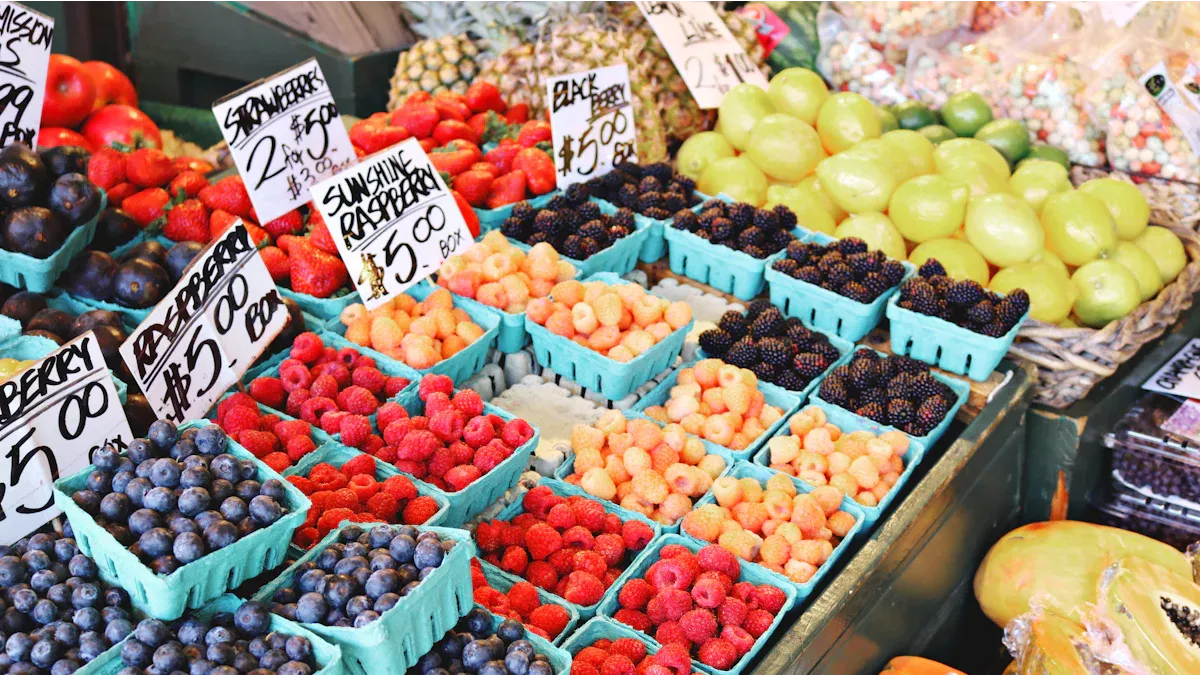Is Local Food Really More Expensive? Debunking the Myth in Chicagoland
- Healthy Living
- Posted 8 months ago
When you hear “local food,” do you automatically think it’s pricier than supermarket options? You’re not alone. Many people assume local food comes with a premium price tag, but that’s not always true. In Chicagoland, local food prices often compete with or even beat supermarket prices. For example:
Whole Foods prices are 29% higher than the average grocery store prices in the area.
Mariano’s, known for fresh produce, offers prices about 5% lower than the average.
Fresh Thyme Market combines quality and affordability, with prices 2% below the average.
These numbers show that local food prices vs supermarket options may surprise you. It’s time to rethink what “local” really means for your wallet.
Key Takeaways
Local food can cost less or match store prices in season.
Buying fresh, seasonal food from farmers saves money and tastes better.
Farmers markets often sell cheaper than stores, helping farmers earn more.
Joining a CSA program saves money and helps local farmers.
Saving seasonal food lets you enjoy it all year and spend less.
Local Food Prices vs Supermarket: A Cost Comparison

When it comes to local food prices vs supermarket options, you might think supermarkets always win on cost. But that’s not the full story. Let’s break it down by looking at seasonal produce, protein sources, and the differences between farmers markets and grocery stores.
Seasonal Produce: Local vs. Supermarket Prices
Seasonal produce is where local food truly shines. When fruits and vegetables are in season, local farmers often have an abundance of fresh options. This surplus can lead to lower prices compared to imported produce at supermarkets. For example, locally grown apples, carrots, and potatoes are typically cheaper during their peak seasons. You’ll not only save money but also enjoy produce that’s fresher and more flavorful.
Supermarkets, on the other hand, rely on imported goods when certain items are out of season locally. These imports often come with higher transportation costs, which get passed on to you. By choosing local, you avoid these added costs and support farmers in your community. Plus, buying in bulk during peak seasons and preserving produce for later use can stretch your dollar even further.
Protein Sources: Eggs, Milk, and Meat
Protein is another area where local food prices vs supermarket options might surprise you. Local eggs, for instance, are often comparable in price to those from large-scale farms. In some cases, they’re even cheaper, especially when you buy directly from farmers. The same goes for milk and certain cuts of meat. Locally sourced protein doesn’t just compete on price—it often offers better quality and freshness.
Vegetarian protein sources like legumes are also a budget-friendly option. These are widely available at farmers markets and can help you reduce overall protein costs. Whether you’re shopping for animal-based or plant-based proteins, local options can provide excellent value without compromising on quality.
Farmers Markets vs. Grocery Stores: Breaking Down the Costs
Farmers markets offer a unique shopping experience that goes beyond just buying food. Here, farmers retain up to 90 cents on the dollar from sales, compared to only 17.4 cents at grocery stores. This direct-to-consumer model often results in lower prices for you, especially for seasonal produce. In fact, studies show that in 74% of communities, farmers market prices are on average 22% lower than supermarket prices.
Buying in bulk at farmers markets during peak seasons can lead to even greater savings. For example, you can stock up on fresh tomatoes or berries and preserve them for later use when prices typically rise. Beyond the cost savings, shopping at farmers markets allows you to connect with local farmers, fostering a sense of community and trust that’s hard to find in a grocery store.
By exploring these options, you’ll see that local food isn’t just about supporting your community—it’s also a smart financial choice.
Why Local Food Seems More Expensive
You might wonder why local food sometimes feels pricier than supermarket options. The truth is, several factors contribute to this perception. Let’s break it down.
The Role of Seasonality and Availability
Seasonality plays a big role in local food pricing. When crops are in season, local farmers often have plenty to sell, which can lower prices. But when the growing season ends, availability drops, and prices may rise. This fluctuation can make local food seem expensive during off-seasons.
Extreme weather events also impact crop yields. For example:
Impact Type | Description |
|---|---|
Crop Yields | Extreme weather events can significantly reduce crop yields, leading to lower food availability. |
Food Prices | Reduced supply due to crop failures can result in increased food prices in local markets. |
Economic Contribution | Agriculture contributes over $750 billion to the U.S. economy, highlighting its importance. |
Climate change adds to the challenge. It causes more frequent droughts, floods, and unpredictable weather. These conditions can:
Threaten food safety and availability.
Disrupt supply chains when storms damage crops.
When you buy local, you’re directly supporting farmers who face these challenges. While prices may vary, the quality and freshness of local food often make it worth the cost.
Transportation and Supply Chain Differences
Local food supply chains are shorter than those of supermarkets. This means your food travels fewer miles to reach your plate. For example, beef in a local supply chain travels far less than the 1,500 miles it often covers in mainstream supermarket chains. Shorter distances can reduce transportation costs, which is a win for both your wallet and the environment.
However, mainstream supply chains have their own efficiencies. Larger trucks carry more products, which lowers the fuel use per 100 pounds of food. This efficiency can offset some of the cost advantages of shorter distances in local supply chains. Even so, local food often wins on freshness and taste because it doesn’t spend days or weeks in transit.
Perception of Exclusivity and Small-Scale Production
The idea that local food is exclusive or “premium” can also make it seem more expensive. Small-scale farmers don’t have the same economies of scale as large corporations. They produce smaller quantities, which can lead to higher prices for certain items. But this isn’t always the case. Many local farmers offer competitive prices, especially when you buy directly from them at farmers markets.
Think of it this way: when you buy local, you’re paying for more than just food. You’re investing in your community, supporting sustainable practices, and enjoying fresher, higher-quality products. That’s a value supermarkets can’t always match.
The True Value of Local Food

Health Benefits of Fresher, Less Processed Food
When you choose local food, you’re getting fresher options that haven’t spent days traveling or sitting in storage. Fresher food means fewer preservatives and less processing, which can make a big difference for your health. Locally grown fruits and vegetables retain more nutrients because they’re harvested at peak ripeness. Compare that to supermarket produce, which is often picked early to survive long shipping times.
Studies show that communities with strong food policies have better access to healthy options. For example:
Farmers markets increase access to fresh produce by 2.2 times.
Transportation supports improve food access by 2.2 times.
Community planning documents boost healthy food availability by 2 times.
These numbers highlight how local food systems prioritize health. By eating locally, you’re not just enjoying better-tasting food—you’re also investing in your well-being.
Environmental Impact: Reducing Food Miles
Local food travels fewer miles to reach your plate. This reduces the carbon footprint of your meals and helps the environment. For instance, a locally sourced tomato might travel just 50 miles, while a supermarket tomato could cover over 1,500 miles. Shorter distances mean less fuel consumption and fewer emissions.
Buying local also supports sustainable farming practices. Many small-scale farmers use eco-friendly methods like crop rotation and organic fertilizers. These practices protect soil health and reduce water pollution. When you shop locally, you’re helping the planet while enjoying fresher, tastier food.
Supporting Local Farmers and Strengthening Communities
Every dollar you spend on local food supports farmers in your area. Unlike supermarket chains, where profits often go to large corporations, local farmers keep most of the money from their sales. This helps them sustain their businesses and invest in better farming practices.
Local food also strengthens your community. Farmers markets create spaces where neighbors connect and share stories. They foster a sense of belonging and trust. When you buy local, you’re not just purchasing food—you’re building relationships and supporting the people who grow your meals.
Choosing local food is more than a transaction. It’s a way to invest in your health, protect the environment, and uplift your community.
How to Save Money on Local Food
Saving money on local food is easier than you might think. With a few smart strategies, you can enjoy fresh, local produce without breaking the bank.
Shopping Smart at Farmers Markets
Farmers markets are treasure troves of fresh produce, but navigating them wisely can maximize your savings. Here are some proven strategies:
Shop the Clean Fifteen and Dirty Dozen: Focus on buying local or organic items from the Dirty Dozen list and local or conventional items from the Clean Fifteen list. This approach helps you save while prioritizing health.
Walk the Entire Market Before Buying: Take a stroll around the market to compare prices and yields. This ensures you make informed decisions and get the best deals.
Talk to the Vendors: Don’t hesitate to chat with vendors. Ask about discounts for bulk purchases, weekly shopping, or ‘seconds’—imperfect produce sold at lower prices.
Have a Plan for What You Bought: Create a meal plan to use your purchases effectively. This reduces waste and maximizes value.
Joining a CSA (Community Supported Agriculture)
Joining a CSA can be a game-changer for your grocery budget. Here’s how it works:
Aspect | Description |
|---|---|
Membership Model | Members pay upfront for a share of the season’s produce, providing farms with early capital. |
Direct investment reduces intermediary costs, allowing consumers to access lower prices. | |
Community Support | Strengthens local economies by ensuring fair compensation for farmers and reducing waste. |
By investing in a CSA, you not only save money but also support local farmers and enjoy a steady supply of fresh produce.
Preserving Seasonal Produce for Later Use
Preserving seasonal produce is a fantastic way to enjoy local flavors year-round. Here are some techniques:
Description | Benefits | |
|---|---|---|
Blanching | Immersing foods in hot water or steam, then cooling quickly. | Extends shelf-life, improves texture, color, and flavor retention. |
Pickling | Adding acetic acid or salt to achieve a low pH. | Preserves fresh flavors, adds unique tastes, and prevents pathogens. |
Fermentation | Using microbes to metabolize sugars, producing lactic acid. | Enhances flavors, adds probiotics, and lowers pH for safety. |
These methods help you make the most of local food prices vs supermarket options by extending the usability of your purchases.
By shopping smart, joining a CSA, and preserving produce, you can enjoy the benefits of local food without overspending. It’s all about making informed choices and planning ahead.
Local food in Chicagoland isn’t always more expensive. It depends on what you’re buying, the season, and where you shop. For example:
Chicago’s farmers markets host over 70 vendors offering fresh fruits, vegetables, and flowers. Prices often drop during peak seasons when availability is high.
Independently owned grocery stores near Chicago also provide local options, with prices varying by market type and seasonal supply.
The Consumer Price Index for the Chicago area shows food prices fluctuate throughout the year. This highlights how seasonal factors impact costs.
By exploring farmers markets, joining a CSA, or preserving seasonal produce, you can enjoy fresh, affordable food while supporting your community. Why not give it a try? You might be surprised by the value you find!
FAQ
What makes local food different from supermarket food?
Local food is fresher because it’s harvested closer to your home. It doesn’t travel long distances, so it retains more nutrients and flavor. Supermarket food often comes from far away, which means it’s picked early and stored longer.
Is local food always organic?
Not always! Many local farmers use organic practices but don’t pay for certification. You can ask them directly about their methods. This way, you’ll know exactly how your food is grown without relying on labels.
How can I find local food near me?
You can visit farmers markets, join a CSA, or check out local grocery stores that stock regional produce. Apps and websites like LocalHarvest.org can also help you locate nearby options. 🥕
Why does local food sometimes cost more?
Local farmers don’t have the same economies of scale as big corporations. They grow smaller quantities and focus on quality. However, buying in season or in bulk can help you save money while supporting your community.
Can I save money by buying local food?
Absolutely! Seasonal produce at farmers markets is often cheaper than supermarket prices. Joining a CSA or preserving food for later use can also stretch your budget. Plus, you’re investing in fresher, healthier options. 💡
Tip: Plan your meals around what’s in season to maximize savings!
See Also
Choosing Between Farmers Markets And Farm Stands For Your Family

